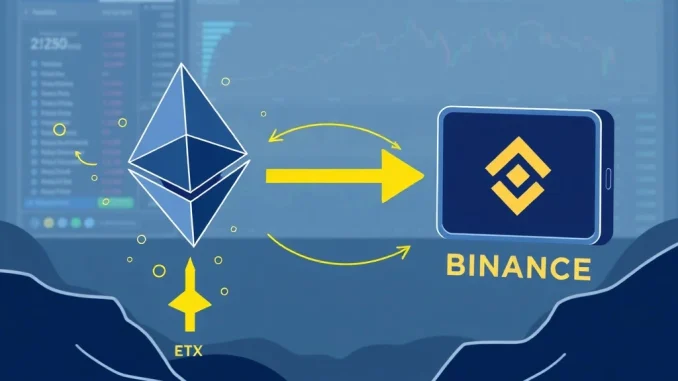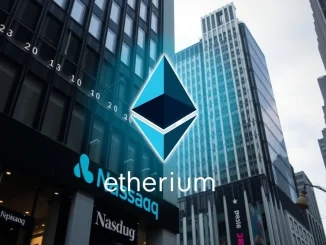
In the fast-paced world of cryptocurrency, every major move by an exchange or large wallet can send ripples through the market. Recently, the crypto community’s attention was drawn to a significant **HTX ETH transfer**, a movement of a staggering 50,600 ETH, valued at approximately $181 million, from HTX to Binance. This isn’t just a routine transaction; it’s a meticulously tracked on-chain event that raises questions and sparks curiosity among traders and investors alike.
Understanding the HTX ETH Transfer Dynamics
On-chain analyst @EmberCN on X was quick to highlight this substantial **HTX ETH transfer**, noting that it followed a pattern observed in previous large movements. The sequence of events is critical to understanding the underlying implications:
Withdrawal from Aave: The journey began with the ETH being withdrawn from Aave, a popular decentralized lending protocol. What’s particularly noteworthy is that the withdrawal originated from a wallet identified as the ‘HTX Recovery Wallet’.
Movement to HTX’s Hot Wallet: Following the Aave withdrawal, the funds were then routed to HTX’s hot wallet. Hot wallets are typically used for operational liquidity, facilitating frequent transactions for users.
Final Destination: Binance: The final leg of the transfer saw the entire sum of 50,600 ETH being sent to Binance, the world’s largest cryptocurrency exchange by trading volume.
This systematic flow, especially involving a ‘recovery wallet’ and then an immediate **Binance ETH deposit**, suggests a strategic move rather than a spontaneous one. But what does it mean?
The Role of On-Chain Analysis in Unveiling Patterns
The ability to track such transactions is thanks to sophisticated **on-chain analysis**. This field involves examining publicly available blockchain data to gain insights into market movements, whale activity, and exchange behaviors. For this particular **HTX ETH transfer**, on-chain analysts are looking for:
Historical Context: Is this part of a larger, ongoing series of transfers? The mention of a ‘pattern’ by EmberCN is key. HTX, formerly Huobi, has faced security incidents in the past, including a recent hack. The ‘Recovery Wallet’ designation could be linked to managing assets recovered or re-consolidating funds after such events.
Liquidity Management: Exchanges frequently move funds between their own wallets, cold storage, and other exchanges for various reasons, including rebalancing liquidity, preparing for large withdrawals, or optimizing asset distribution across their infrastructure. A large **Binance ETH deposit** could indicate HTX is bolstering its ETH liquidity on Binance to facilitate certain trading pairs or services.
Market Impact: While a transfer between exchanges doesn’t directly mean a sale, a large inflow of ETH to a major exchange like Binance can sometimes be interpreted as an increase in potential selling pressure, as more ETH becomes readily available for trading. However, it could also be for arbitrage or other strategic trading purposes.
Understanding these nuances is crucial, as misinterpretations can lead to unnecessary market volatility.
What Does the HTX Recovery Wallet Imply?
The specific mention of the ‘HTX Recovery Wallet’ adds another layer of intrigue. In the aftermath of security breaches or significant operational events, exchanges often designate specific wallets for managing affected or recovered funds. For HTX, this could be related to their efforts following the October 2023 hack where they lost millions. While HTX quickly recovered the funds and offered a bug bounty, such events necessitate careful asset management. This **HTX recovery wallet** activity might indicate:
Consolidation of Assets: Moving recovered or safeguarded assets from a decentralized protocol like Aave back into a centralized exchange environment for better control or specific operational needs.
Strategic Positioning: Perhaps preparing these assets for a specific use case, such as covering user withdrawals, facilitating a large institutional trade, or participating in specific DeFi protocols through Binance’s broader ecosystem.
Without official statements from HTX, these remain educated assumptions based on the transparent nature of blockchain data.
The Broader Crypto Exchange Flow Picture
Large **crypto exchange flow** movements like this are constantly monitored by market participants because they offer a glimpse into the supply-side dynamics of cryptocurrencies. When significant amounts of an asset move onto exchanges, it can signal an increased willingness to sell, potentially leading to price depreciation if demand doesn’t keep pace. Conversely, large outflows from exchanges can indicate accumulation by long-term holders, often seen as a bullish signal.
However, it’s vital to remember that not all exchange inflows are bearish. Exchanges also use these movements for:
Internal Rebalancing: Shifting assets between hot and cold wallets or different exchange addresses to manage risk and liquidity.
Arbitrage Opportunities: Moving funds to capitalize on price discrepancies between exchanges.
OTC (Over-The-Counter) Deals: Facilitating large trades that don’t go through the public order books.
The HTX to Binance transfer is a prime example of a complex on-chain event that requires careful interpretation, moving beyond simple assumptions about buying or selling pressure.
Conclusion: Navigating the On-Chain Landscape
The recent **HTX ETH transfer** to Binance serves as a compelling reminder of the transparency and complexity inherent in the blockchain ecosystem. While the direct implications for the market remain speculative without further context from HTX, the meticulous **on-chain analysis** provided by experts like EmberCN offers invaluable insights into the movements of major players. These large transfers are not just numbers; they are pieces of a larger puzzle, revealing patterns of liquidity management, recovery efforts, and strategic positioning by major exchanges. As the crypto market matures, understanding these intricate **crypto exchange flow** dynamics will become increasingly important for investors seeking to make informed decisions. Keep a watchful eye on these movements, as they often precede significant shifts in market sentiment and price action.



